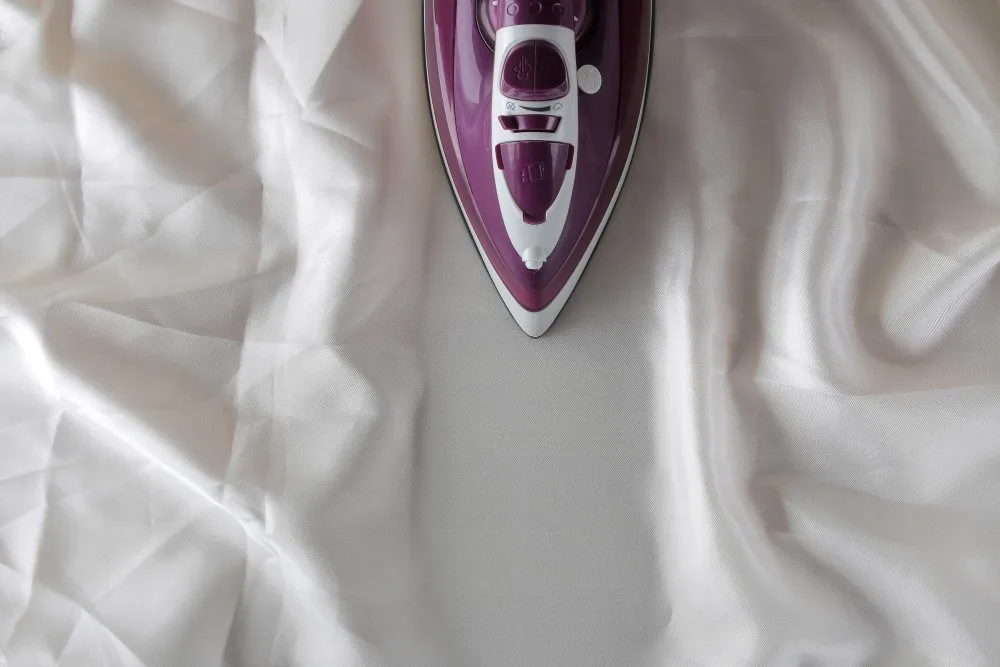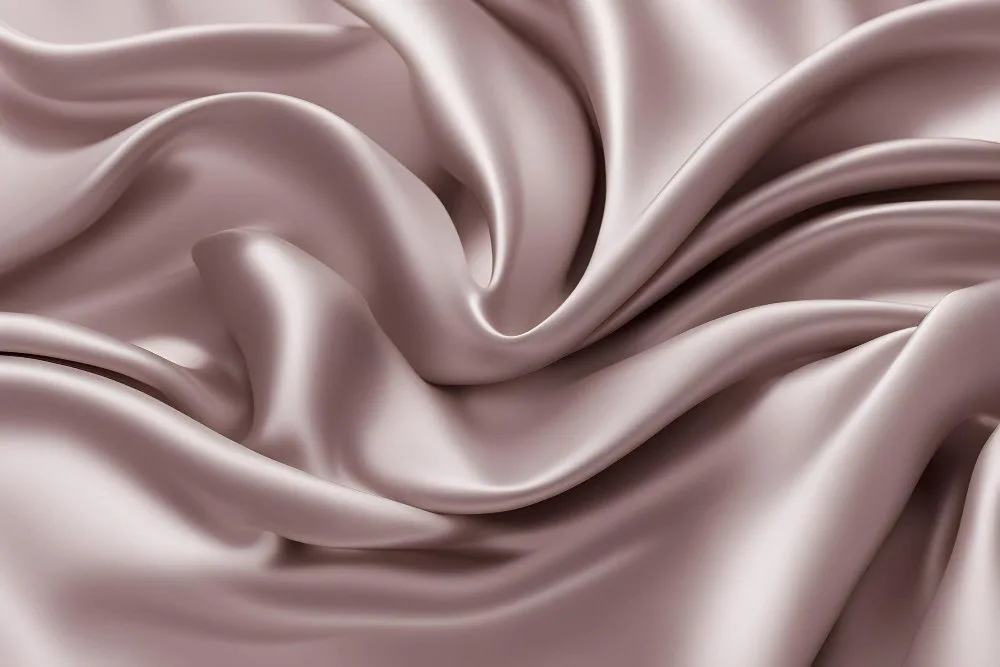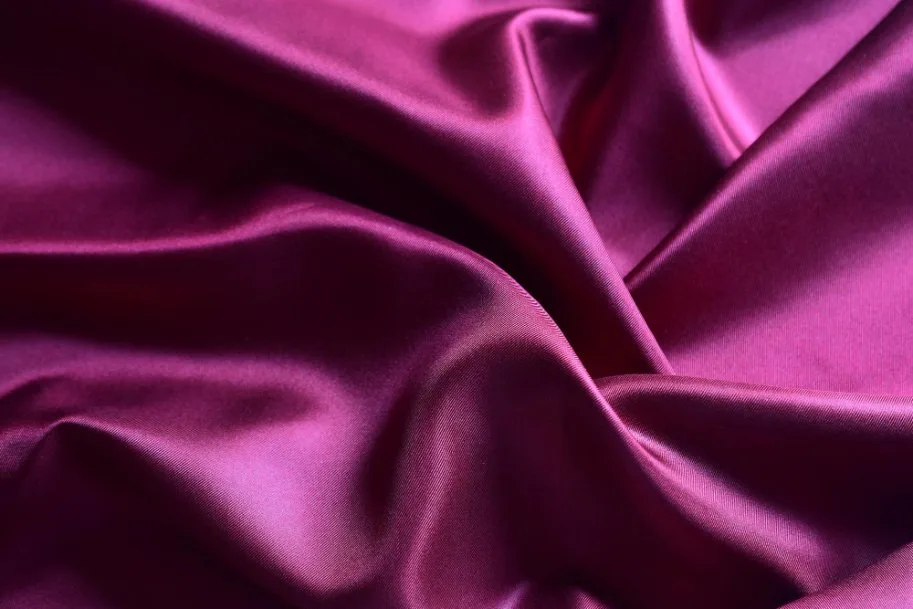Your Complete Guide to Washing, Storing & Maintaining Silk Fabrics at Home
Silk clothing adds elegance to any wardrobe, but many people feel anxious about caring for this beautiful fabric. Taking care of silk at home is actually simple when you follow the right steps. This guide will show you everything you need to know about silk care, from washing techniques to long-term storage.
While silk may seem delicate, it’s actually the strongest natural fiber known. The secret is treating it gently, especially when wet since silk loses about 30% of its strength during washing. With proper care, your silk pieces can stay gorgeous for decades.
Table of Contents
Quick Reference: Essential Silk Care Facts
| Care Aspect | Best Practice | What to Avoid |
|---|---|---|
| Washing | Cool water (30°C), gentle detergent | Hot water, harsh chemicals |
| Drying | Lay flat, away from sunlight | Tumble dryer, direct heat |
| Storage | Padded hangers, breathable bags | Plastic bags, wire hangers |
| Ironing | Low heat with pressing cloth | High heat, steam directly on fabric |
Want personalized care instructions? Use our Silk Care Calculator to get instant, customized recommendations based on your specific fabric type and any stains you’re dealing with.
Understanding Silk: What Makes It Special
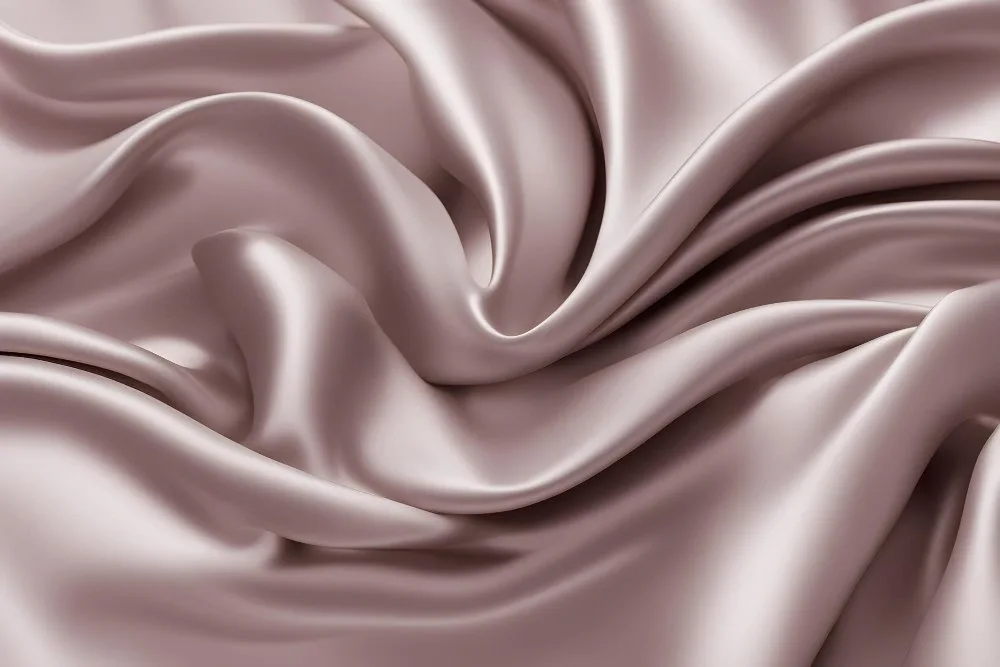
Silk stands out as one of the world’s most prized natural fibers. Understanding its unique properties helps you care for it properly and appreciate why it requires special handling compared to synthetic fabrics.
Characteristics That Make Silk Unique
Pure silk fabric feels incredibly smooth and soft against your skin. The natural protein fibers create a lightweight yet strong material that can absorb up to 30% of its weight in moisture without feeling damp.
Your silk items will keep you cool in summer and warm in winter thanks to their natural temperature-regulating abilities. The fibers reflect light in a way that creates silk’s signature shimmering appearance.
Silk is naturally hypoallergenic and resistant to:
- Dust mites
- Mold
- Mildew
- Bacteria
Recent research from Cornell University’s Department of Human Centered Design has revealed fascinating new insights into silk’s natural properties. Studies conducted by textile researchers at Cornell found that silk’s unique protein structure gives it exceptional absorption capabilities, with silk yarn demonstrating 90% dye removal efficiency within just 10 minutes. This research not only highlights silk’s remarkable natural properties but also demonstrates why proper care is so important – the same absorption qualities that make silk valuable for environmental applications also mean it readily absorbs oils, perfumes, and stains from everyday use.
Different Types of Silk and Their Care Needs
Mulberry silk represents the highest quality and most common type. It comes from silkworms that feed exclusively on mulberry leaves, producing uniform white fibers with excellent durability.
Other notable silk varieties include:
- Tussar silk: Wild silk with a rich golden color and slightly coarser texture
- Muga silk: Known for its glossy fine texture and natural golden hue
- Eri silk: Warm and durable, often called “peace silk” because it’s harvested without harming silkworms
Each type has unique traits that affect its appearance and care requirements. When shopping, check the label for “100% silk” to ensure you’re getting pure silk rather than a blend with synthetic materials.
Not sure what type of silk you have? Our Interactive Fabric Identifier can help you identify whether you have Mulberry, Tussar, Muga, or Eri silk by simply uploading a photo.
How Do You Take Care of Silk? Essential Preparation Steps
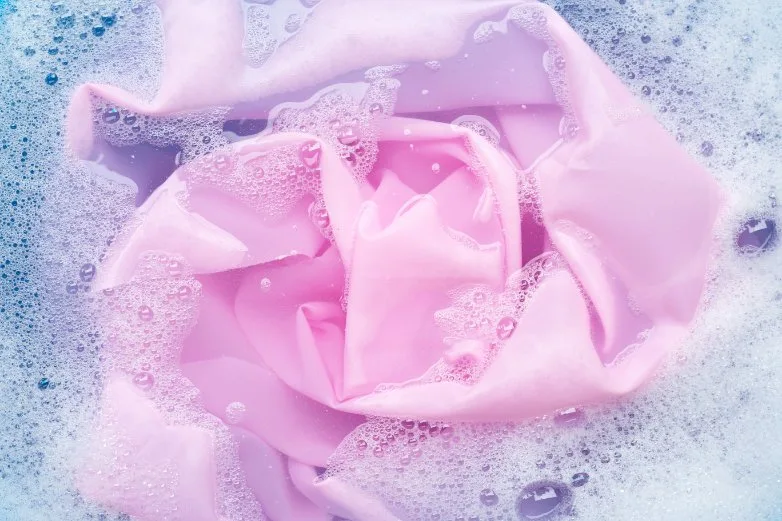
Proper preparation protects your silk investment and prevents costly damage. Taking a few minutes to check labels and prepare items properly makes all the difference.
Reading Silk Care Labels Like a Pro
Check the care label on your silk items before doing anything else. Look for “100% silk” since blended fabrics need different care methods. Pay close attention to specific washing instructions, as some items marked “dry clean only” should never be washed at home.
Common silk care symbols to know:
- 30°C in a circle = machine washable on delicate
- Hand with waves = hand wash only
- Circle with an X = dry clean only
- Iron symbol with dots = iron on low heat
How to Properly Prepare Silk for Cleaning
Inspect your silk items carefully for any stains, tears, or loose threads. Spot-clean visible stains before washing to prevent them from setting permanently.
Pre-washing checklist:
- Empty all pockets completely
- Close zippers and buttons
- Turn items inside out to protect the surface
- Sort by color (wash dark and light silks separately)
- Use a mesh laundry bag for delicate pieces
- Remove any brooches, pins, or detachable decorations
Test colorfastness on a hidden area by dabbing with a damp white cloth. If color transfers, take the item to a professional cleaner instead.
Professional Demonstration: Silk Preparation Techniques
The following video provides a comprehensive visual guide to the preparation methods discussed in this section. These techniques, demonstrated by textile care professionals, show the proper handling and assessment procedures essential for silk maintenance.
Following this visual overview, we’ll examine each preparation step in greater detail with specific instructions for different types of silk items.
Does Silk Really Have to Be Dry Cleaned?
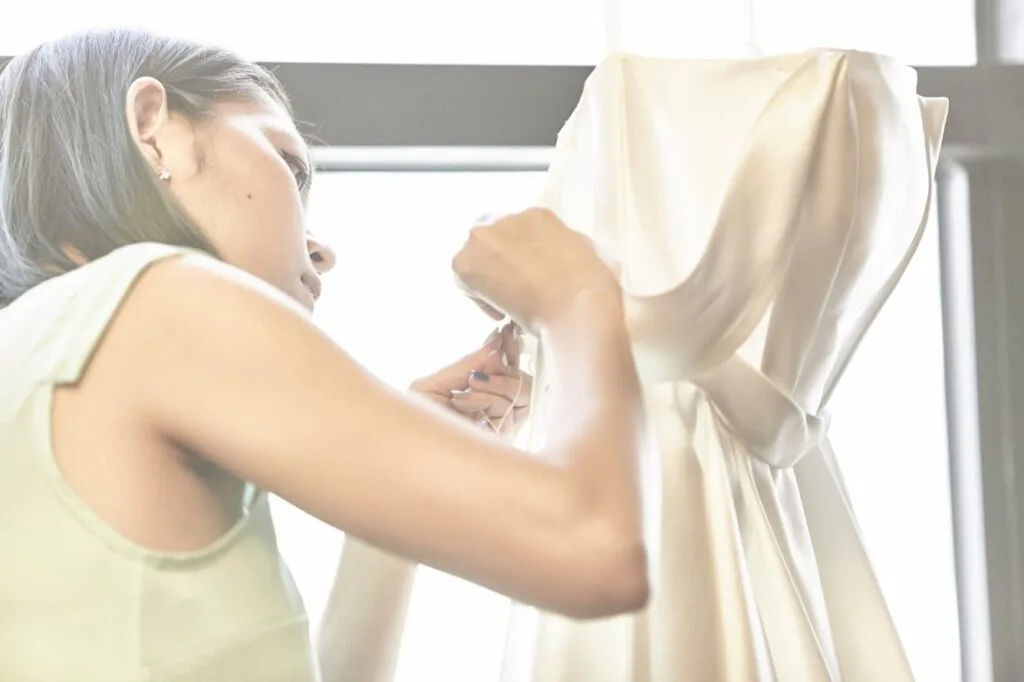
Not all silk requires dry cleaning. Many silk items can be safely washed at home if you follow proper techniques. The key is understanding when home washing is appropriate and when professional cleaning is necessary.
Items safe for home washing:
- Silk scarves and accessories
- Some silk blouses (check the label)
- Silk pillowcases and sheets
- Simple silk garments without complex construction
Items that need professional cleaning:
- Structured silk jackets or blazers
- Silk items with beading or embellishments
- Vintage or delicate antique silk pieces
- Items specifically labeled “dry clean only”
What Happens If I Wash 100% Silk?
When you wash 100% silk properly, it comes out clean and maintains its beautiful properties. However, washing silk incorrectly can cause several problems:
Potential issues from improper washing:
- Shrinkage (especially with hot water)
- Color bleeding or fading
- Loss of natural sheen
- Rough or stiff texture
- Permanent water spots or stains
What happens when you wash silk correctly:
- Fibers remain intact and strong
- Natural sheen is preserved
- Fabric stays soft and smooth
- Colors remain vibrant
- Longevity is maintained
Washing Silk: Step-by-Step Methods
Proper silk washing techniques protect the delicate fibers and keep your garments looking beautiful. Whether you choose hand washing or machine washing, gentle treatment is essential.
Hand Washing Technique (Recommended Method)
Fill a clean sink with cool water at 30°C (86°F). Add a small amount of silk-specific detergent or mild soap designed for delicates. Regular detergents can be too harsh and damage the protein fibers.
Step-by-step hand washing:
- Gently submerge your silk item
- Swish it around softly (never rub or scrub)
- Let the item soak for 3-5 minutes maximum
- Rinse thoroughly with cool water until all soap is removed
- Press out excess water between clean towels
- Never twist, wring, or squeeze the fabric
What Is the Best Detergent for Silk?
Choose specialized silk detergents or mild, enzyme-free cleaners designed for delicates. These maintain the fabric’s pH balance and won’t strip natural oils from the fibers.
Recommended detergent types:
- Silk-specific detergents (like The Laundress Delicate Detergent)
- Mild baby shampoo (in a pinch)
- Woolite Delicates
- Plant-based, enzyme-free detergents
Avoid these products:
- Regular laundry detergent
- Bleach or whitening agents
- Fabric softeners
- Products with optical brighteners
See It in Action: Silk Washing Made Easy
Washing silk might seem intimidating, but this video breaks it down into simple, manageable steps. You’ll see exactly how gentle you need to be and what the process should look like from start to finish.
Ready to try it yourself? Here are the detailed methods for washing your silk items safely at home.
Can I Wash Silk with Shampoo?
Yes, you can wash silk with mild baby shampoo in emergencies. Baby shampoo is gentle and pH-balanced, making it safer than regular detergents. Use about a teaspoon per gallon of cool water, and follow the same gentle washing process.
Machine Washing Tips for Silk
Some silk items can be machine washed, but only if the care label permits it. Use these precautions to minimize damage:
Machine washing guidelines:
- Use a mesh laundry bag for protection
- Select the delicate cycle with cold water
- Set spin speed to low or gentle
- Use only silk-safe detergent
- Remove items promptly when the cycle ends
- Keep similar colors together to prevent dye transfer
Never put silk in the dryer, even on low heat. The tumbling action and heat can cause irreversible damage.
Why Shouldn’t You Tumble Dry Silk? Proper Drying Methods
Tumble drying ruins silk by exposing it to excessive heat and mechanical stress. The combination of high temperatures and constant tumbling breaks down the protein fibers and can cause severe shrinkage.
Problems caused by tumble drying:
- Fiber breakdown and weakening
- Severe shrinkage (often irreversible)
- Loss of natural sheen and smoothness
- Wrinkles that are difficult to remove
- Potential tearing or holes
Safe Silk Drying Techniques
Drying silk properly requires specific techniques that protect the delicate fibers while ensuring complete moisture removal. This video walks you through the process from start to finish.
Follow along with our detailed instructions below to master these essential silk drying methods.
Never put silk in the dryer. Instead, lay silk flat on a clean towel away from direct sunlight and heat sources. This preserves the fiber integrity and prevents damage.
Proper drying steps:
- Gently roll the item in a clean towel to remove excess water
- Lay flat on a fresh, dry towel
- Reshape the garment while damp
- Keep away from radiators, heaters, and direct sunlight
- Allow 2-4 hours for complete air drying
- Turn the item over halfway through drying if needed
A mesh drying rack works well since it allows air circulation on both sides. The key is patience – rushing the drying process always leads to problems.
Can Silk Be Ironed? Safe Ironing and Steaming
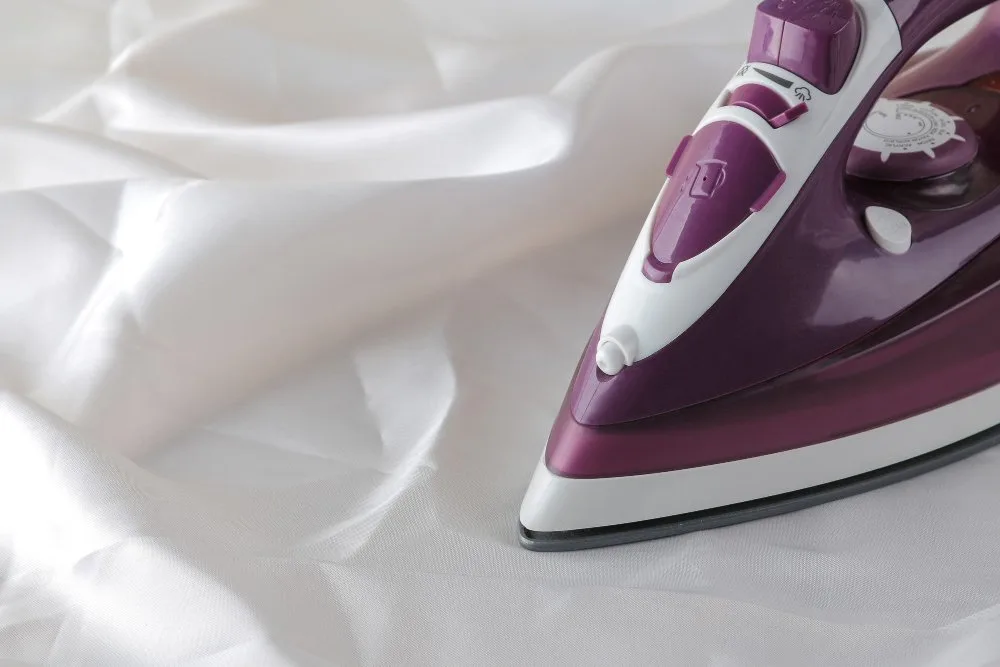
Yes, silk can be ironed, but it requires special care to avoid damage. Always use low heat and protective measures to preserve the fabric’s integrity.
Safe Ironing Procedures for Silk
Use the lowest heat setting specifically marked for silk. Turn garments inside out before pressing to protect the visible surface from potential heat damage.
Ironing silk safely:
- Set iron to silk/low heat setting
- Turn the garment inside out
- Place a clean white cotton cloth between iron and silk
- Test on a hidden area first
- Press gently without dragging the iron
- Work in small sections
- Hang immediately after ironing
Never use steam when ironing silk directly. Water spots can permanently stain the fabric, and the combination of heat and moisture can cause shrinkage.
Is It Okay to Steam 100% Silk?
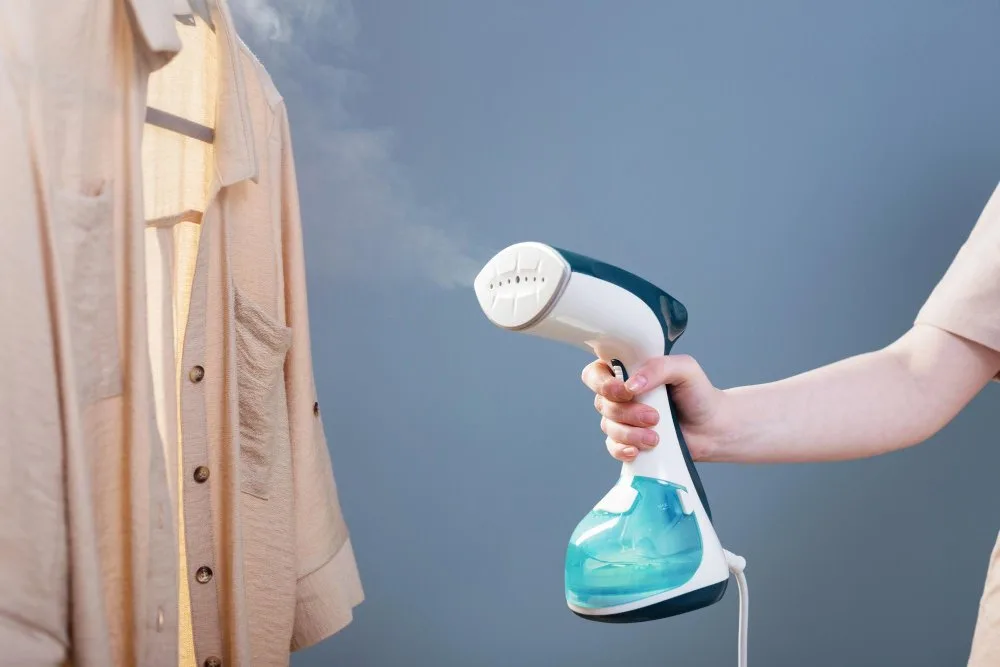
Steaming can be safe for silk if done correctly. Use a handheld steamer held at least 6 inches away from the fabric. Keep the steamer moving to prevent water spots and never let condensation build up on the silk.
Safe steaming tips:
- Maintain 6+ inches distance from fabric
- Keep the steamer moving constantly
- Work in a well-ventilated area
- Test on an inconspicuous area first
- Hang the garment immediately after steaming
How to Get Wrinkles Out of Silk
Multiple methods for wrinkle removal:
- Bathroom steam method: Hang silk in a steamy bathroom for 10 minutes
- Professional steaming: Use a handheld steamer at safe distance
- Low-heat ironing: With protective cloth and inside-out placement
- Damp towel rolling: Roll garment in slightly damp towel while fresh from washing
For stubborn wrinkles, hanging the garment in a humid environment often works better than applying direct heat.
Why Does Silk Feel Stiff After Washing?
Silk can feel stiff after washing due to soap residue, hard water minerals, or using the wrong detergent. This stiffness isn’t permanent and can usually be corrected.
Common causes of stiff silk:
- Soap or detergent residue left in fibers
- Hard water mineral deposits
- Using regular laundry detergent instead of silk-specific products
- Water temperature too hot during washing
- Not rinsing thoroughly enough
How to Make Silk Soft and Shiny Again
Restoration techniques:
- Vinegar rinse: Mix 1 tablespoon white vinegar with 1 quart cool water, soak for 2-3 minutes, then rinse thoroughly
- Extra rinse cycles: Rinse multiple times with cool water to remove all residue
- Distilled water final rinse: Use distilled water for the final rinse to eliminate mineral deposits
- Proper drying: Ensure complete air drying away from heat sources
The vinegar treatment is particularly effective because it removes soap buildup and restores the silk’s natural pH balance.
How to Restore Silk After Washing
If your silk has lost its luster or feels different after washing, several restoration methods can help bring it back to life.
Professional Restoration Options
For valuable or severely damaged silk items, consider professional restoration services. They have specialized equipment and treatments not available for home use.
DIY Restoration Methods
For lost sheen:
- White vinegar rinse (1 tablespoon per quart of water)
- Professional silk conditioner treatment
- Gentle brushing with a soft natural bristle brush when dry
For stiffness:
- Multiple cool water rinses to remove residue
- Switch to silk-specific detergent for future washings
- Avoid fabric softeners, which can coat the fibers
Can You Use Fabric Softener on Silk?
No, never use fabric softener on silk. Fabric softeners coat the fibers with synthetic chemicals that can:
- Block the silk’s natural breathability
- Reduce moisture-wicking properties
- Create a waxy buildup that attracts dirt
- Dull the natural shine permanently
- Cause allergic reactions on sensitive skin
Silk is naturally soft and doesn’t need artificial softening agents. The key to maintaining softness is proper washing and drying techniques.
Storing Silk Items for Longevity
Proper storage prevents damage like wrinkles, yellowing, and fiber breakdown. The right techniques and materials protect silk’s natural sheen and strength for years. Understanding both short-term and long-term storage requirements ensures your silk collection remains beautiful and wearable for decades.

Comprehensive silk storage guide showing short-term and long-term storage methods, storage best practices versus mistakes to avoid, and ideal climate conditions including temperature range 65-75°F and humidity 45-55%
Short-Term Storage (Daily and Seasonal)
Store silk items loosely to allow air circulation. Never use plastic hangers or bags since they trap moisture and can cause mildew.
Daily storage tips:
- Use padded hangers for dresses and blouses to prevent stretching
- Fold heavy silk pieces like coats flat with tissue paper between folds
- Keep items away from direct sunlight and heat sources
- Ensure adequate space between garments in the closet
- Use cedar blocks or lavender sachets for natural pest deterrence
Long-Term Preservation Methods
For items you won’t wear for months, take extra precautions to ensure they remain in perfect condition.
Long-term storage essentials:
- Clean items thoroughly before storing (even invisible stains can become permanent)
- Wrap in breathable cotton storage bags or acid-free boxes
- Place acid-free tissue paper between silk layers
- Store in cool, dark, dry areas (65-75°F with 45-55% humidity)
- Check stored items every few months for signs of pests or deterioration
Storage location guidelines:
- Avoid basements and attics with temperature fluctuations
- Choose interior closets away from exterior walls
- Ensure good air circulation in storage areas
- Keep away from heating vents and windows
Special Care for Different Silk Items
Different silk pieces require tailored care approaches to maintain their quality and extend their lifespan. Understanding the specific needs of accessories, bedding, garments, and vintage pieces ensures each item receives appropriate treatment for optimal preservation.
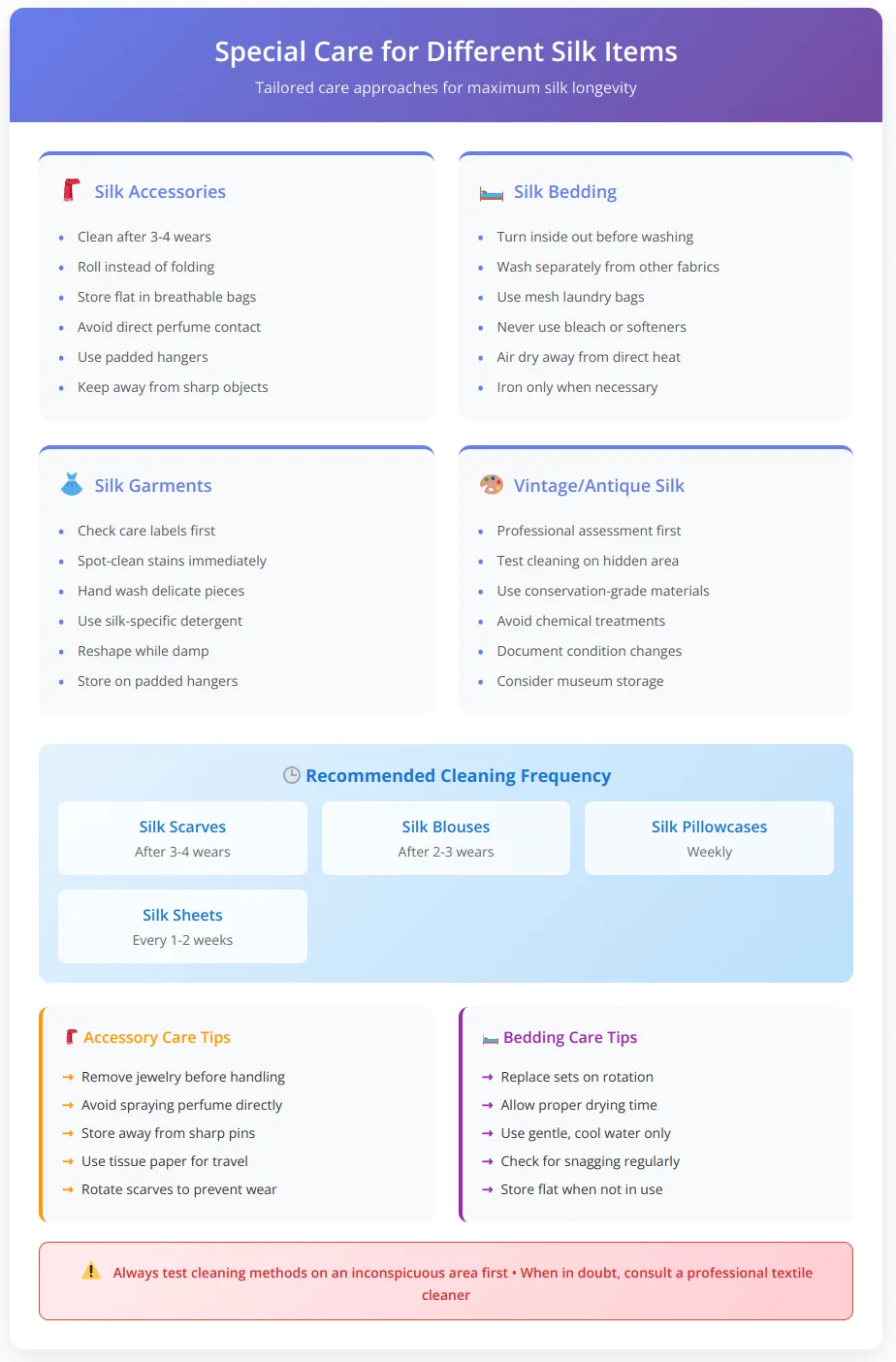
Each type of silk item has unique characteristics that influence how it should be cleaned, stored, and maintained. By following these specialized approaches, you can ensure every piece in your silk collection remains beautiful and functional for years to come.
Caring for Silk Accessories
Clean silk scarves after 3-4 wears to prevent dirt buildup. Roll them gently instead of folding to avoid permanent crease lines.
Silk accessory care:
- Store flat in breathable cloth bags
- Avoid spraying perfume directly on silk items
- Remove jewelry before handling delicate silk pieces
- Use padded hangers for heavier silk scarves
- Keep pins and sharp objects away from silk
Maintaining Silk Bedding
Silk pillowcases and sheets need gentle washing in cold water with mild detergent. Turn items inside out before washing to protect the surface that touches your skin.
Silk bedding care specifics:
- Wash silk duvet covers separately from other fabrics
- Use mesh laundry bags for extra protection during machine washing
- Air dry away from direct heat and sunlight
- Iron only when necessary using low heat and protective cloth
- Replace bedding sets on rotation to extend overall life
Benefits of proper silk bedding care:
- Maintains natural temperature regulation
- Preserves moisture-wicking properties
- Prevents hair tangles and skin irritation
- Extends the lifespan of expensive silk bedding
What Ruins Silk? Common Mistakes to Avoid
Understanding what damages silk helps you avoid costly mistakes and preserve your investment pieces.
Environmental Factors That Damage Silk
Heat damage:
- Direct sunlight fading and weakening fibers
- High temperatures during washing or drying
- Storage near heating sources
- Using hot irons without protection
Moisture problems:
- Excessive humidity causing mildew
- Water spots from direct steam contact
- Storing in damp environments
- Not allowing complete drying before storage
The Smithsonian Institution, which preserves countless historic silk textiles, emphasizes that silk is extremely susceptible to light damage, which can be seen in brittleness, splits, and eventual powdering of fibers. Their conservation experts note that weighted silks (which were common in Victorian-era textiles) are particularly vulnerable because metallic salts used in processing accelerate deterioration. This institutional knowledge from decades of preserving historic silk pieces reinforces why protecting your silk items from light exposure and understanding their specific vulnerabilities is crucial for long-term preservation.
Chemical and Physical Damage
Harsh chemicals to avoid:
- Bleach or whitening agents
- Regular laundry detergents with enzymes
- Stain removers not designed for protein fibers
- Alcohol-based products that can dissolve silk
Physical stress factors:
- Aggressive rubbing or scrubbing
- Wringing or twisting wet silk
- Hanging heavy items on wire hangers
- Overcrowding in storage spaces
Does Sweat Ruin Silk?
Sweat can damage silk over time, but it’s not immediately destructive. Understanding how perspiration affects silk fibers and knowing the right prevention and treatment methods can help you protect your investment while still enjoying your silk garments comfortably.
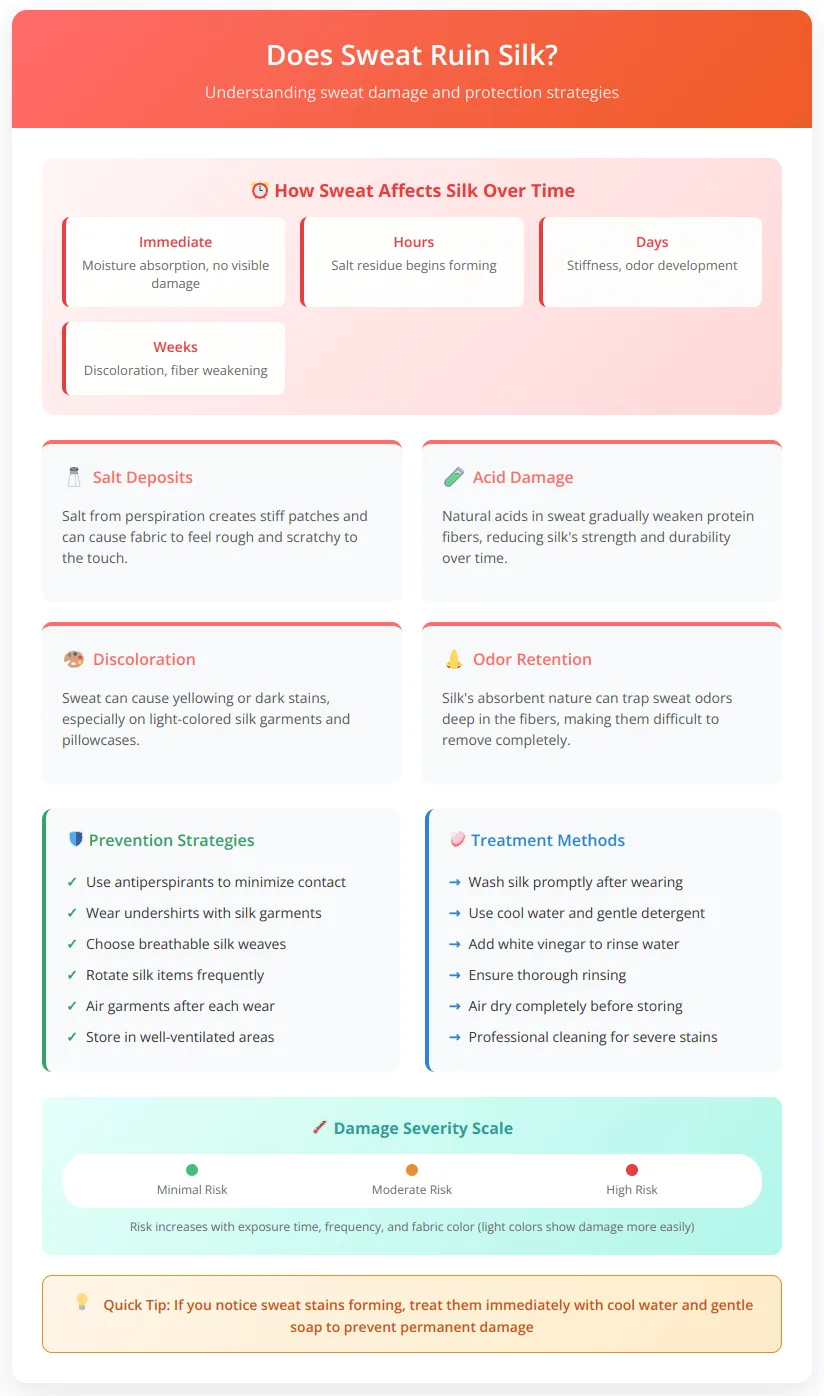
The key to managing sweat and silk is understanding that while damage can occur, it’s preventable with the right approach. Let’s examine exactly how sweat affects silk and what you can do about it.
How sweat affects silk:
- Salt deposits can make fabric feel stiff
- Acids can gradually weaken protein fibers
- Staining may occur, especially on light-colored silk
- Odors can become trapped in the fibers
Prevention and treatment:
- Wash silk items promptly after wearing
- Use antiperspirants to minimize contact
- Consider wearing undershirts with silk garments
- Treat sweat stains immediately with cool water
- Ensure thorough rinsing to remove all salt residue
Can Silk Get Wet?
Yes, silk can get wet, but it becomes much more fragile when moisture is present. Understanding how water affects silk’s properties helps you handle wet silk safely and prevent damage.

While silk can safely get wet during proper care, understanding its vulnerability when moisture is present helps you handle it correctly. The key is gentle treatment and immediate proper drying to restore the fabric’s full strength.
When silk gets wet:
- Handle with extreme care to prevent tearing
- Avoid pulling or stretching the fabric
- Don’t wring or twist wet silk
- Lay flat immediately to prevent distortion
- Keep away from heat sources while drying
Emergency wet silk care:
- Blot (don’t rub) excess water with clean towels
- Reshape the garment while damp
- Allow slow air drying in a flat position
- Avoid moving or handling until completely dry
Does Silk Degrade Over Time?
Like all natural materials, silk does degrade over time, but proper care significantly slows this process. Understanding degradation factors and prevention strategies helps maximize your silk’s lifespan.

Understanding that silk naturally ages helps you make informed decisions about care and preservation. With proper attention to environmental factors and handling, quality silk can remain beautiful and functional for decades.
Natural aging factors:
- UV light exposure causes gradual fiber weakening
- Air pollutants can accumulate and cause discoloration
- Natural oils in the fabric can oxidize over time
- Mechanical stress from wearing gradually weakens fibers
Signs of silk degradation:
- Loss of natural sheen and luster
- Increased brittleness or stiffness
- Color fading or yellowing
- Small holes or weak spots developing
- Reduced elasticity and drape
Slowing degradation:
- Store away from light and heat
- Clean regularly to remove damaging pollutants
- Handle gently to minimize mechanical stress
- Use proper hangers and storage methods
- Address stains and damage promptly
How Can You Tell If Silk Is High Quality?
Recognizing quality silk helps you make better purchasing decisions and adjust your care routine accordingly. Understanding the key indicators of premium silk ensures you invest in pieces that will last and perform as expected.

These identification techniques help you distinguish between premium silk and lower-grade alternatives, ensuring you get the quality you’re paying for.
Physical Quality Indicators
High-quality silk characteristics:
- Smooth, even texture without slubs or irregularities
- Natural luster that’s not overly shiny
- Good drape and fluid movement
- Consistent color throughout the fabric
- Fine, tightly woven construction
Lower quality signs:
- Rough or uneven texture
- Excessive shine or artificial appearance
- Stiff or board-like feel
- Color variations or streaks
- Loose weave with visible gaps
The Burn Test for Silk Authentication
This test helps distinguish real silk from synthetic imitations:
- Remove a small thread from a hidden area
- Light it with a match in a safe environment
- Real silk burns slowly with a smell like burning hair
- Synthetic materials melt or burn with chemical odors
- Real silk leaves a black, crushable ash
Note: Only perform this test on a small, hidden sample and in a safe environment.
Troubleshooting Common Silk Problems
Quick action and proper techniques can fix most silk issues and prevent permanent damage. Having the right approach for each type of problem ensures the best chance of restoration.
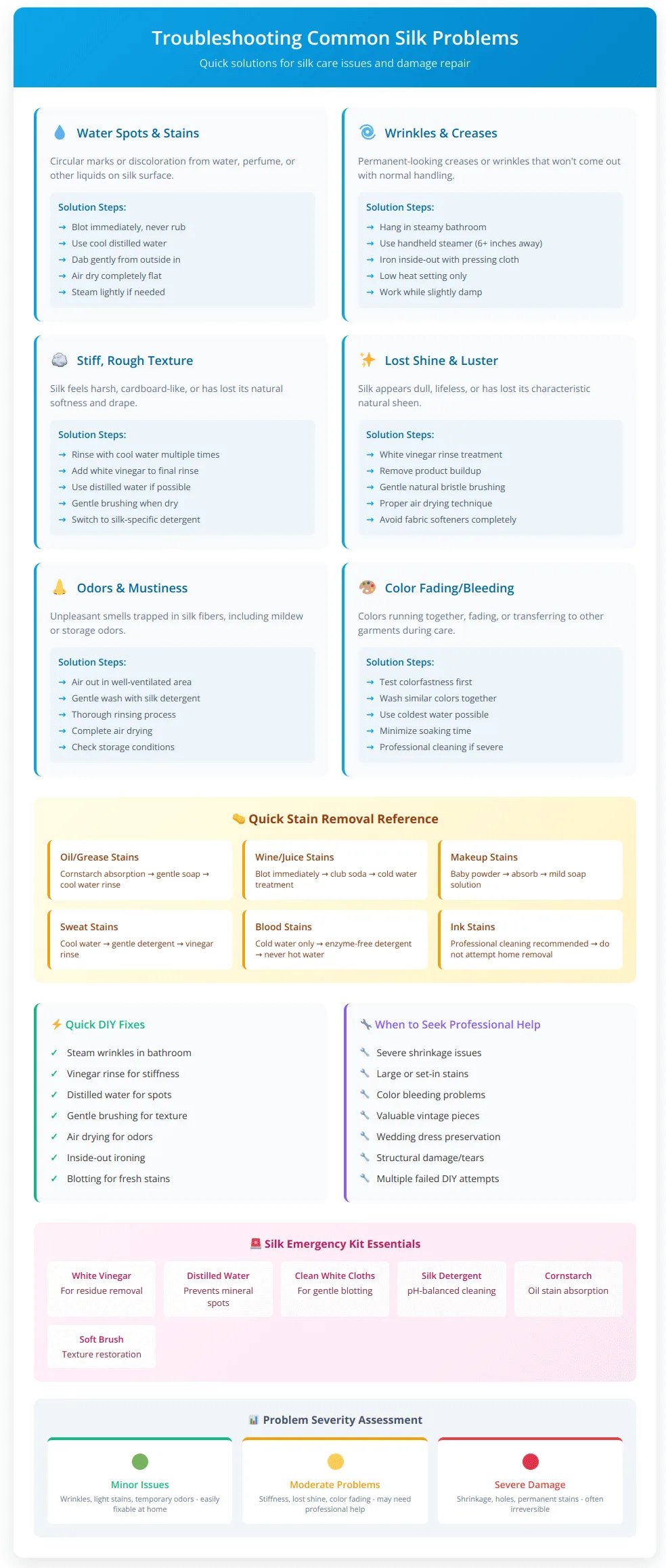
Most silk problems are solvable when caught early and treated properly. Having the right supplies and knowing when to seek professional help can save valuable pieces from permanent damage. Quick action is always your best defense.
Stain Removal for Silk
Remove stains from silk immediately by blotting with a clean white cloth. Never rub stains, as this can damage the delicate fibers permanently.
Need specific stain treatment instructions? Our Silk Care Calculator provides detailed, step-by-step stain removal guidance based on your exact stain type and silk fabric.
Stain treatment by type:
| Stain Type | Treatment Method | What to Avoid |
|---|---|---|
| Water-based (juice, wine) | Club soda and gentle blotting | Rubbing or scrubbing |
| Oil-based (makeup, food) | Cornstarch absorption, then mild soap | Hot water or harsh detergents |
| Protein-based (blood, sweat) | Cold water and enzyme-free detergent | Hot water (sets the stain) |
| Ink or dye | Professional cleaning recommended | Alcohol or bleach |
Emergency stain care:
- Blot immediately with clean, white material
- Use cool water for initial treatment
- Test any cleaning solution on a hidden area first
- Seek professional help for valuable items or stubborn stains
Why Is My Silk Not Shiny Anymore?
Loss of shine usually results from improper care, product buildup, or natural aging. Several factors can restore silk’s natural luster:
Common causes of lost shine:
- Soap or detergent residue buildup
- Hard water mineral deposits
- Using fabric softeners or wrong detergents
- Heat damage from improper drying or ironing
- Natural aging and wear
Restoration methods:
- White vinegar rinse to remove buildup
- Switch to silk-specific detergents
- Use distilled water for washing
- Gentle brushing with natural bristle brush when dry
- Professional cleaning for valuable pieces
What Is the Difference Between Silk and Satin?
Many people confuse silk and satin, but they’re completely different things. Understanding this distinction helps you make informed purchasing decisions and apply the correct care methods.
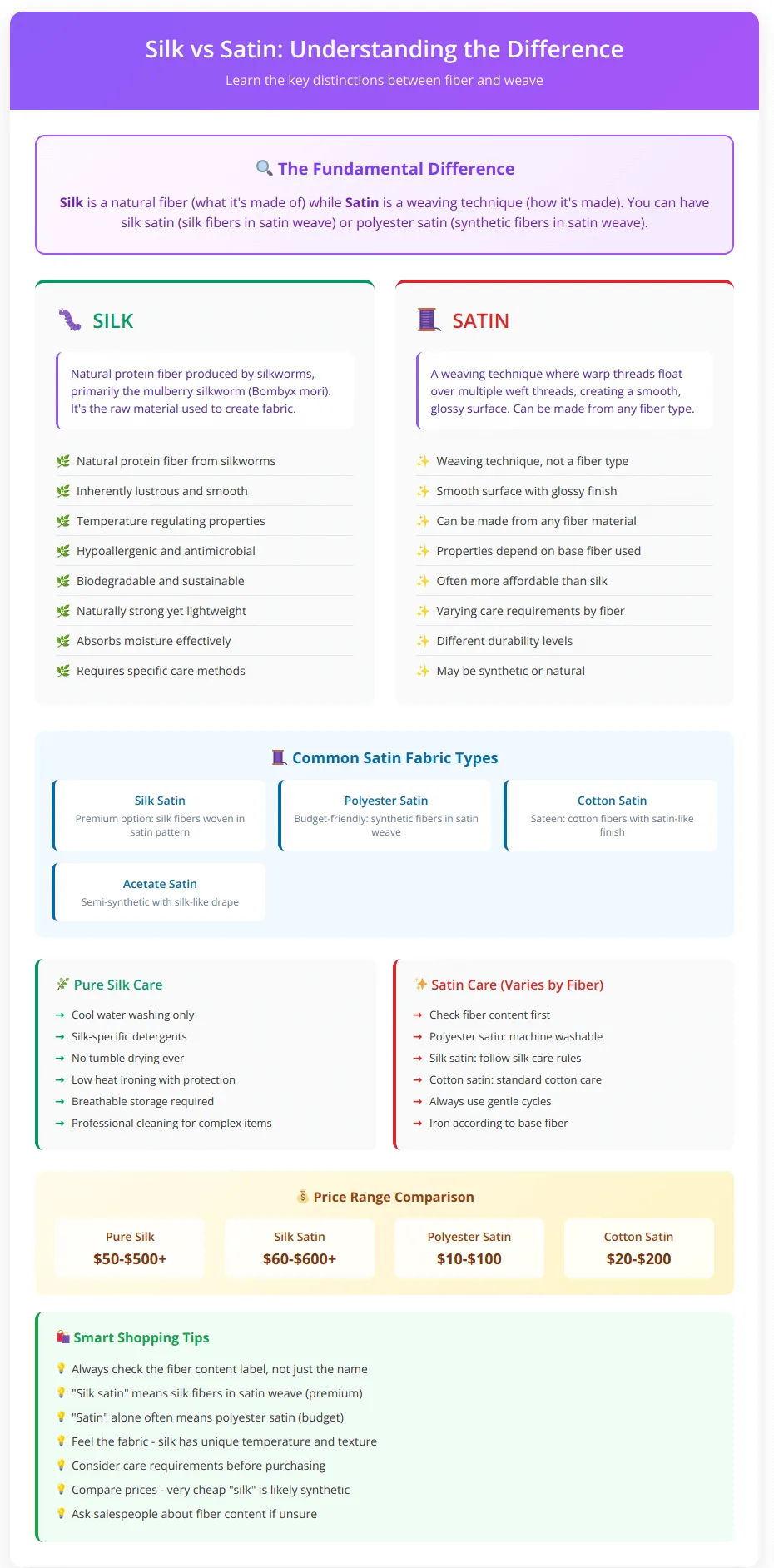
Remember: silk refers to the fiber material, while satin describes how the fabric is woven. This fundamental difference affects everything from care requirements to pricing.
Silk characteristics:
- Natural protein fiber from silkworms
- Inherently lustrous and smooth
- Temperature regulating and breathable
- Hypoallergenic and antimicrobial
- Requires specific care methods
Satin characteristics:
- Weaving technique, not a fiber type
- Can be made from silk, polyester, or other materials
- Smooth surface with glossy finish
- Care requirements depend on the fiber used
- Often less expensive than pure silk
When shopping, check labels carefully. “Silk satin” indicates silk fibers woven in a satin pattern, while “polyester satin” uses synthetic fibers in the same weave.
What Not to Do with Silk: Critical Care Mistakes
Understanding what damages silk helps you avoid costly mistakes and preserve your investment pieces. These critical errors can cause irreversible harm, but they’re completely preventable with proper knowledge.
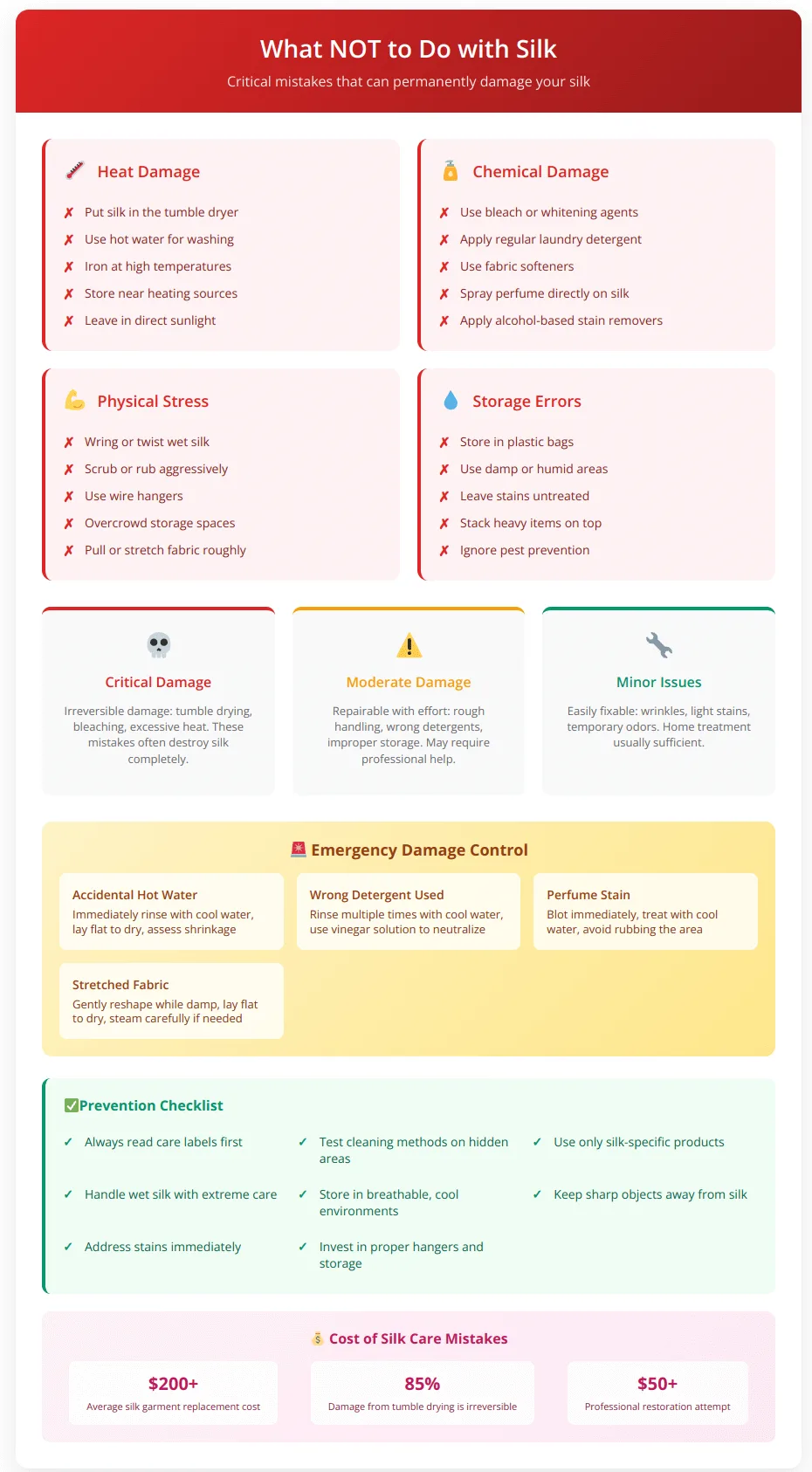
By avoiding these critical mistakes, you can ensure your silk pieces remain beautiful and functional for years. Prevention is always better than attempting to repair damage after it occurs.
Never do these things:
- Put silk in the tumble dryer
- Use hot water for washing or rinsing
- Apply bleach or harsh stain removers
- Wring, twist, or squeeze wet silk
- Store in plastic bags or containers
- Spray perfume directly onto silk
- Use regular laundry detergent
- Iron at high temperatures without protection
- Leave stains untreated for extended periods
- Store in damp or humid environments
What Happens If You Tumble Dry Silk?
Tumble drying silk causes multiple types of severe, often irreversible damage. Understanding the timeline and types of damage helps explain why air drying is the only safe method for silk care.

The damage from tumble drying happens quickly and is almost always permanent. Even a few minutes can cause irreversible harm that professional cleaning cannot repair. Air drying is not just recommended for silk – it’s absolutely essential for preserving your investment.
Problems Caused by Tumble Drying
Immediate effects:
- Shrinkage that’s often irreversible
- Loss of natural sheen and smoothness
- Fiber breakage from mechanical stress
- Wrinkles that are difficult to remove
Long-term consequences:
- Permanent texture changes
- Reduced lifespan of the garment
- Potential holes or tears from weakened fibers
- Complete loss of silk’s beneficial properties
Even low heat settings are dangerous for silk. The mechanical tumbling action combined with any heat causes damage that professional cleaning often cannot repair.
Why Does My Silk Smell When Wet?
Wet silk can develop odors for several preventable reasons, most commonly from trapped body oils, soap residue, or improper drying. Understanding these causes helps you eliminate existing smells and prevent future odor problems.
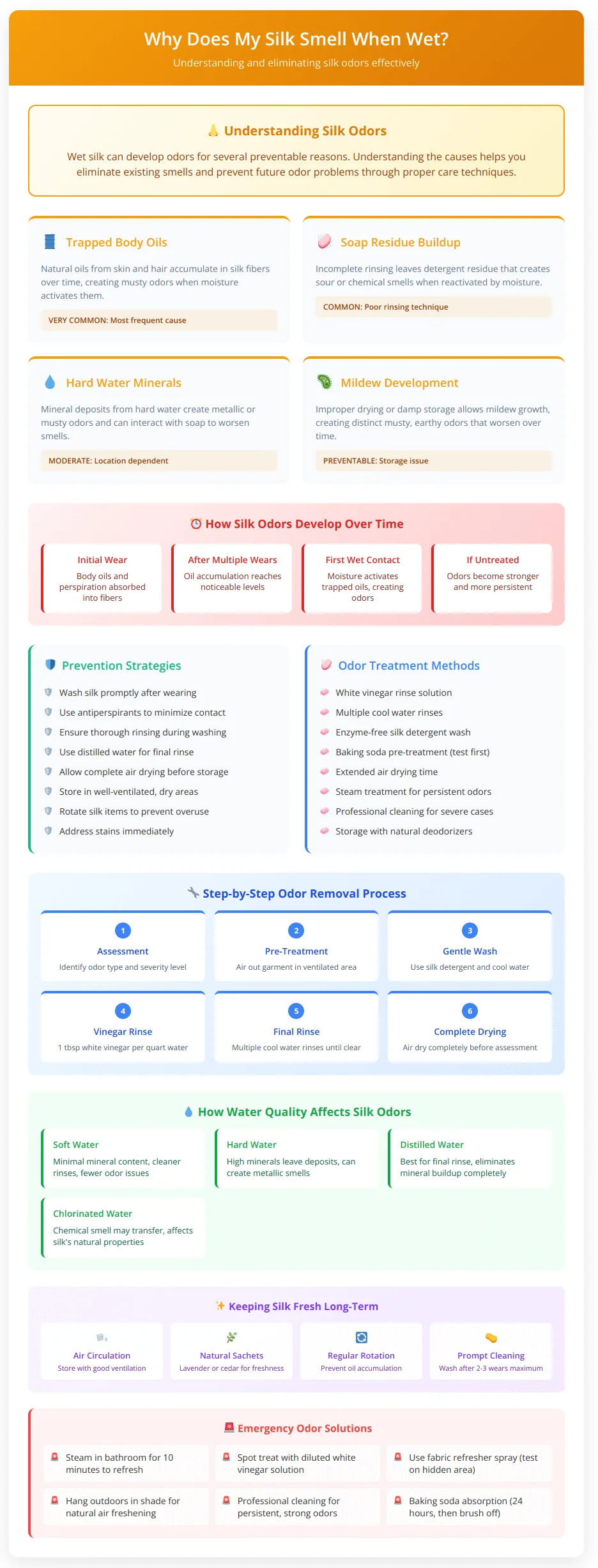
Most silk odor problems are completely preventable with proper care techniques. When odors do develop, prompt treatment with the right methods usually eliminates them completely. The key is understanding that moisture activates trapped substances in the fibers.
Common causes of silk odors:
- Trapped body oils and perspiration
- Incomplete rinsing leaving soap residue
- Mildew from improper drying
- Hard water mineral deposits
- Storage in poorly ventilated areas
Prevention and solutions:
- Wash silk promptly after wearing
- Ensure thorough rinsing during washing
- Use distilled water for final rinse
- Allow complete air drying before storage
- Store in breathable, well-ventilated areas
- Clean silk regularly to prevent buildup
Advanced Silk Care Techniques
Understanding when to handle silk care at home versus seeking professional services can save both money and precious garments. The right choice depends on factors like garment value, complexity, damage severity, and your experience level.

The choice between home and professional care isn’t always clear-cut. Many silk owners use a combination approach: handling routine maintenance at home while relying on professionals for complex issues, valuable pieces, or specialized treatments.
Professional vs. Home Care: When to Choose Each
Choose home care for:
- Simple silk garments without complex construction
- Regular maintenance cleaning
- Items specifically labeled as washable
- Silk accessories and bedding
- Minor stain treatment
Wondering about the cost difference? Use our Silk Care Cost Calculator to see exactly how much you could save by caring for your silk collection at home versus using professional services.
Choose professional care for:
- Structured garments with interfacing or padding
- Vintage or antique silk pieces
- Items with beading, sequins, or embellishments
- Severe stains or damage
- “Dry clean only” labeled items
Seasonal Silk Care Adjustments
Summer care considerations:
- Wash more frequently due to increased perspiration
- Store in extra ventilated areas to prevent humidity damage
- Use antiperspirants to minimize contact with salt and acids
- Check stored items more often for pest activity
Winter care adjustments:
- Allow extra drying time in humid conditions
- Avoid storing near heating sources
- Monitor for static buildup from dry air
- Use humidifiers in storage areas if air is too dry
Environmental Impact and Sustainable Silk Care
Understanding the environmental impact of silk care helps you make more sustainable choices while maintaining your garments properly. Eco-friendly practices benefit both your silk and the planet.
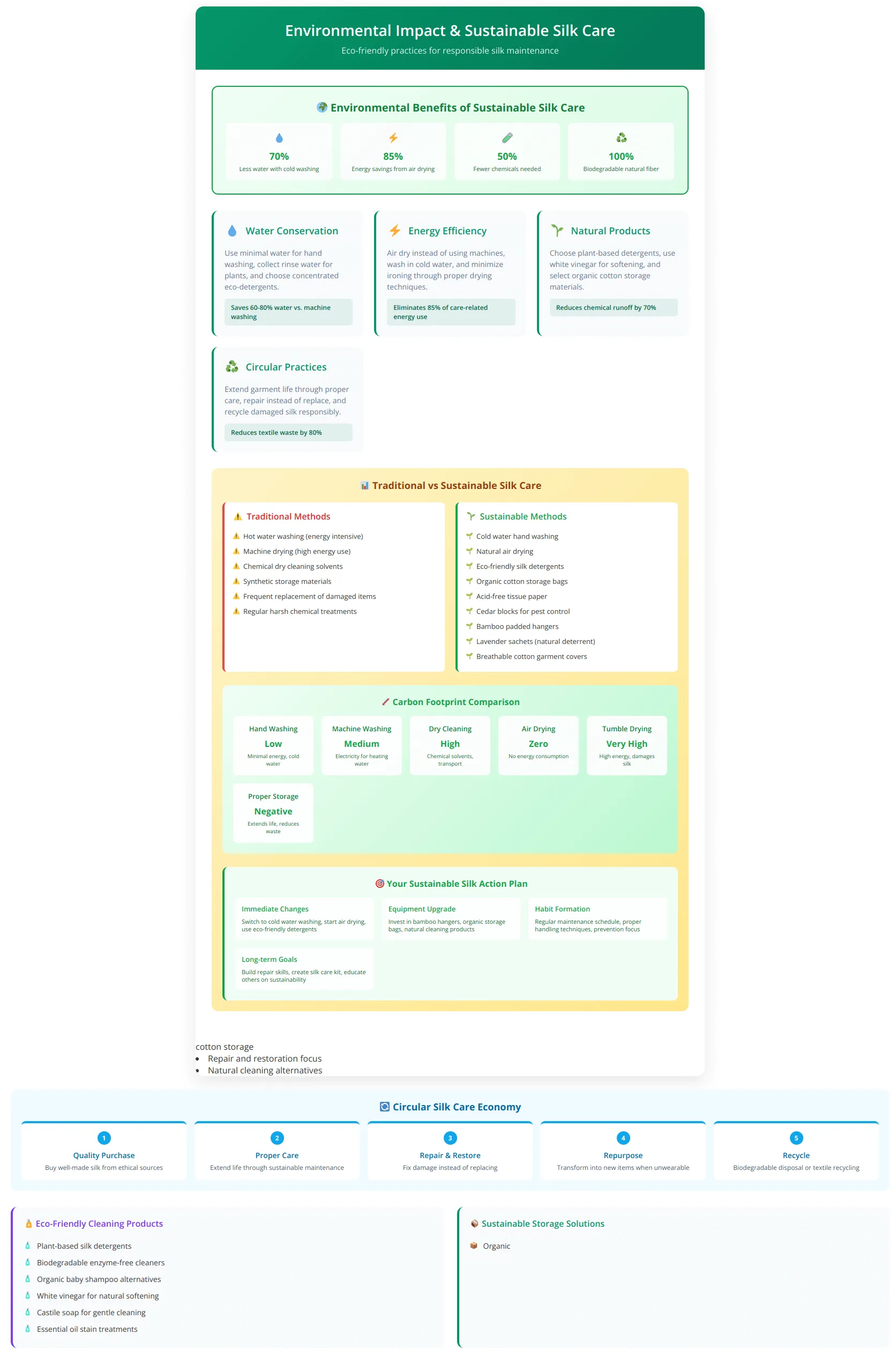
Adopting sustainable silk care practices benefits both your garments and the environment. These eco-friendly methods often provide better results while reducing your environmental footprint and supporting a more sustainable fashion future.
Eco-Friendly Silk Care Practices
Water conservation:
- Use minimal water for hand washing
- Collect and reuse rinse water for plants (if soap-free)
- Choose concentrated, biodegradable detergents
- Wash full loads when machine washing multiple items
Energy efficiency:
- Air dry instead of using machines
- Use cold water for all washing steps
- Choose silk-specific detergents that work in cool water
- Minimize ironing by proper drying techniques
Sustainable products:
- Select plant-based, biodegradable detergents
- Use white vinegar instead of commercial fabric conditioners
- Choose organic cotton storage bags over synthetic materials
- Invest in quality padded hangers that last for years
The Circular Economy and Silk Care
Proper care extends garment life, reducing waste and supporting sustainable fashion practices. Well-maintained silk can last decades, making it an environmentally responsible choice compared to fast fashion alternatives.
Extending silk lifespan:
- Regular maintenance prevents major damage
- Proper storage preserves structural integrity
- Professional repairs address minor issues before they worsen
- Quality care maintains resale value for luxury pieces
Conclusion
Caring for silk doesn’t have to be intimidating once you understand the fundamentals. This natural protein fiber requires gentle treatment, but the reward is clothing that maintains its beauty, comfort, and elegance for years or even decades.
Key Takeaways for Successful Silk Care
Essential care principles:
- Always use cool water and gentle, silk-specific detergents
- Never tumble dry – air drying preserves fiber integrity
- Store properly with padded hangers and breathable materials
- Address stains immediately with appropriate techniques
- Understand when to choose professional cleaning over home care
Critical mistakes to avoid:
- Using hot water, harsh detergents, or fabric softeners
- Wringing, twisting, or roughly handling wet silk
- Storing in plastic or humid environments
- Ignoring care labels and manufacturer instructions
- Delaying treatment of stains or damage
Investment Protection Through Proper Care
Quality silk represents a significant investment in your wardrobe. Proper care techniques protect this investment while ensuring you can enjoy silk’s unique benefits: natural temperature regulation, hypoallergenic properties, and timeless elegance.
Ready to optimize your silk care routine? Try our free tools:
- Silk Care Calculator – Get personalized care instructions
- Fabric Identifier – Identify your silk type from photos
- Care Schedule Generator – Create maintenance timelines
- Cost Calculator – Compare home vs professional care costs
The time spent learning proper silk care pays dividends in garment longevity, maintained appearance, and continued wearing pleasure. Whether you’re caring for a special occasion dress, everyday silk blouses, or luxurious bedding, these techniques ensure your silk items remain beautiful and functional for years to come.
Future-Proofing Your Silk Collection
As you build your silk wardrobe, remember that proper care starts with smart purchasing decisions. Choose quality pieces from reputable manufacturers, understand the specific type of silk you’re buying, and factor care requirements into your decision-making process.
Consider building relationships with trusted professional cleaners for complex or valuable pieces, and invest in proper storage solutions that protect your silk items between wears. With the knowledge and techniques outlined in this guide, you can confidently care for silk at home while knowing when professional help is the best choice.
The beauty of silk lies not just in its appearance, but in its durability when properly maintained. By following these guidelines, your silk pieces will continue to provide comfort, elegance, and style throughout their long lifespan, making them true wardrobe investments rather than temporary fashion purchases.
Frequently Asked Questions
Can you wash 100% silk at home?
Yes, many 100% silk items can be safely washed at home using cool water, gentle detergent, and proper techniques. Always check the care label first and test on a hidden area.
What happens if I accidentally put silk in the dryer?
Tumble drying can cause severe shrinkage, fiber damage, and loss of sheen. Remove immediately and lay flat to air dry. The damage may be permanent, depending on the heat level and duration.
How often should I wash silk clothing?
Wash silk after 2-3 wears for items worn directly against skin, or when visibly soiled. Silk accessories like scarves can go longer between washings unless exposed to perfume or stains.
Create a personalized schedule with our Care Schedule Generator to never miss optimal cleaning times.
Can I use regular detergent on silk?
No, regular detergents contain enzymes and chemicals too harsh for silk’s protein fibers. Use detergents specifically designed for silk or delicate fabrics.
Why does my silk feel different after washing?
Changes in texture usually result from soap residue, hard water minerals, or improper drying. Try a white vinegar rinse and ensure complete air drying away from heat.
Is expensive silk detergent worth it?
Yes, silk-specific detergents maintain proper pH balance and don’t contain enzymes that break down protein fibers. They’re formulated to preserve silk’s natural properties.
Can I steam silk to remove wrinkles?
Yes, but maintain at least 6 inches distance and keep the steamer moving. Never let condensation build up on the fabric, as water spots can stain permanently.
How do I know if my silk is damaged beyond repair?
Signs include holes, severe shrinkage, permanent staining, or complete loss of drape and flexibility. Consult a professional cleaner for assessment of valuable pieces.

